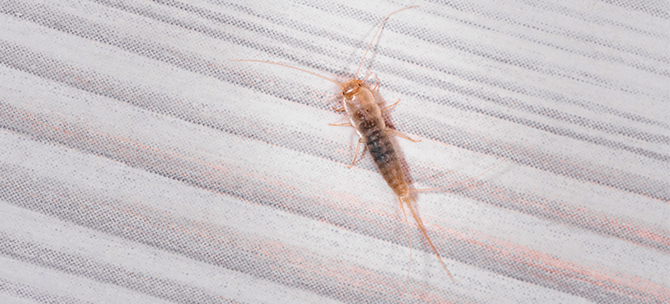Silverfish and Firebrats
Silverfish and firebrats belong to one of the most primitive groups of insects in the order Zygentoma (formerly Thysanura). In this bulletin I will use the term silverfish to describe the morphology and behavior collectively.
Silverfish are commonly distributed throughout North America with four species (one being a firebrat) having been recorded as structural and food pests. Firebrats differ from silverfish only in their preferred harborage requirements of relatively high temperatures, usually provided by man-made appliances (water heaters, boilers, furnaces).
These insects are small (from one-half to less than one inch in length) and carrot-shaped with the head being the broad end. There are two long cerci and a single long tail appendage appearing at the end of the abdomen. They have long thread-like antennae. Silverfish get their common name by the presence of dull gray/silver scales that cover their bodies.
Silverfish prefer habitats that are warm and moist, but can tolerate exposures to extremes of heat and cold seasonally and inside structural spaces like attics and crawl spaces.
Silverfish are secretive pests that do not like brightly-lit spaces nor sites with moving air currents. They are commonly discovered at night when entering a room and turning on a light. Silverfish are fast-running insects and when startled, will run around before escaping to a dark, quiet space.
Silverfish develop through ametabolous metamorphosis. Nymphs appear identical to adults, except for size and scale presence (until the third molt). Immatures will molt anywhere from 15 to 30+ times to reach adulthood. Silverfish are unusual in that they continue to molt after reaching adulthood. Physical mating does not occur. Instead, males will deposit a ball of sperm (spermatophore) and females absorb the deposit when walking over them. Total life span can be over five years.
Silverfish are general scavengers and omnivores. They are attracted to foods with a high content of starchy carbohydrates. They have a history of damaging paper goods, books (pages and bindings) and wall coverings that contain sizing and adhesives made from animal and/or plant sources. They will feed in pest nesting sites (insects, mammals, and birds), and are also attracted to stored foods that are typically aged and frequently contaminated with fungus. Silverfish can endure an extended period of starvation (>1 year).
Management of Silverfish
Non-Chemical
Outdoors: Maintain perimeter sanitation, air flow and ornamental pruning. Seal cracks and openings around windows, door frames and utility penetrations.
Indoors: Control humidity and encourage air flow in basements, crawl spaces and attics. In living spaces, maintain floor-level sanitation by dusting and vacuuming regularly. Change furnace filters regularly. Inspect books, albums, scrapbooks, game and toy boxes for activity or damage, and keep storage areas clean. Importantly, make sure any rodent bait stations are cleaned and freshly-baited, and remove any other pest nesting material and droppings, sanitizing surfaces after removal*.
Insecticides
Outdoors: Apply a labeled residual insecticide as a perimeter treatment and reapply at recommended intervals. Temprid® FX will provide exceptional strength and flexibility; Suspend® PolyZone® will provide extended residual control, resisting wash off and ultraviolet breakdown.
Indoors: Treat with labeled liquid residual insecticides into cracks and crevices and spot treat areas where activity has been reported. Temprid FX and Suspend SC are excellent choices. Use Temprid Ready-to-Spray to inject into deep cracks and crevices and conveniently treat hard-to-reach sites. Dust wall voids behind wall outlets and switch plates, and under insulation in attics. Treat crawl spaces, especially along the sill plate. Use DeltaDust® where moisture may compromise dust performance. Maxforce® Complete granular bait is labeled and effective against silverfish. Use in areas of high activity for extended control. Consider applying a small amount in rodent stations if silverfish are a persistent problem.
*Use appropriate Personal Protective Equipment when servicing these areas.
For more information, contact your local Envu Pest Management & Public Health Representative.


